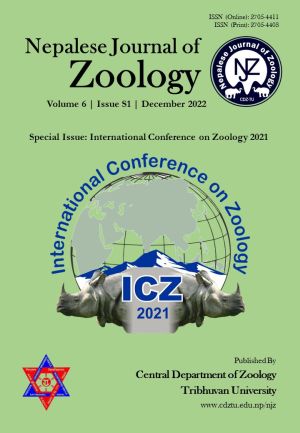Phytoplankton and zooplankton abundance and distribution: a case of Ghodaghodi Lake, Sudurpaschim Province, Nepal
DOI:
https://doi.org/10.3126/njz.v6iS1.50528Keywords:
Chlorophyceae; Phytoplanktons; Zooplanktons; Mesocyclops; ZygnematophyceaeAbstract
Planktons are the community of pelagic organisms, composed of different groups, which are in suspension in water and hence restricted mobility, often less than that of the water which carries them. The study was carried out during the winter of 2019 to observe the phytoplankton and zooplankton abundance and distribution in Ghodaghodi Lake, Nepal. Temperature, pH, electrical conductivity, dissolved oxygen, Secchi disc transparency, total dissolved solids, and turbidity were analyzed during the study. Collection of plankton samples were made by conical-shaped monofilament nylon plankton net of 90 μm mesh net size from approximately 10 ‐ 12 cm depth from six different sites. A total of 58 individuals of zooplankton were enumerated during the present investigation. The maximum number was counted for Mesocyclops sp (n=18) and minimum for Diaptomus (n=1). The highest zooplanktons were reported from site I (n= 12) and the lowest were reported from site II (n=7). Cladocera was the most dominating zooplankton group. A total of 85 individuals of phytoplankton were enumerated during the present investigation. The maximum number was counted for Spirogyra sp (30) and the minimum for Lamena sp (1). The most leading group of the phytoplankton was Chlorophyceae (30), followed by Cyanophyceae (13), Bacillariophyceae (7) and group Zygnematophyceae (6). Thus, these resources are also favorable for flourishing fish diversity in a lake ecosystem.
Downloads
Downloads
Published
How to Cite
Issue
Section
License
Copyright (c) 2022 Melina DC, Archana Prasad, Smriti Gurung, Rita Bhatta, Dikshya Regmi, Shrija Tuladhar, Chhatra Mani Sharma

This work is licensed under a Creative Commons Attribution-NonCommercial 4.0 International License.
This license enables reusers to distribute, remix, adapt, and build upon the material in any medium or format for noncommercial purposes only, and only so long as attribution is given to the creator.

